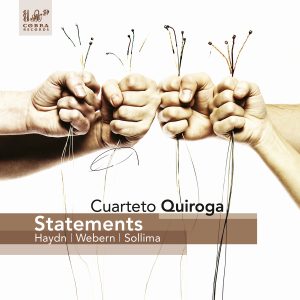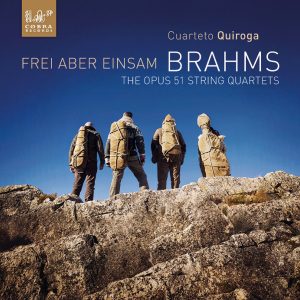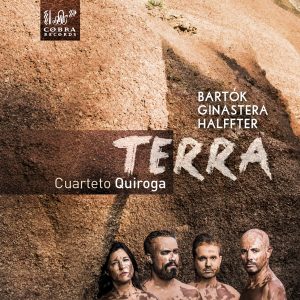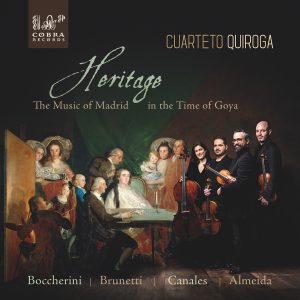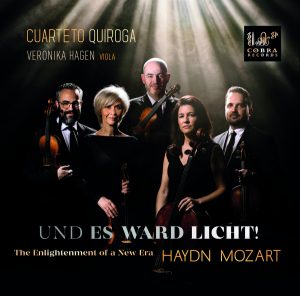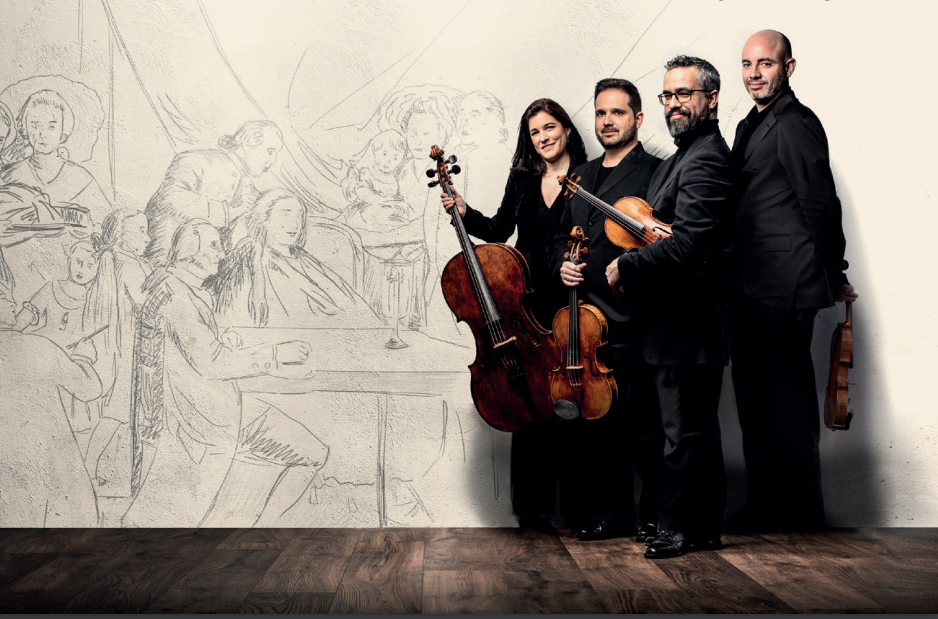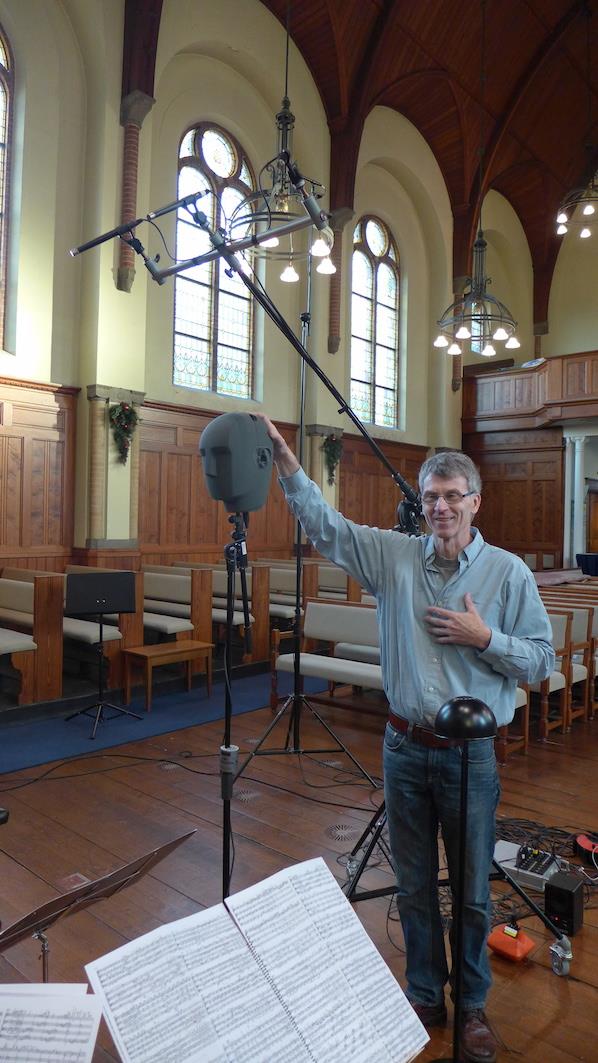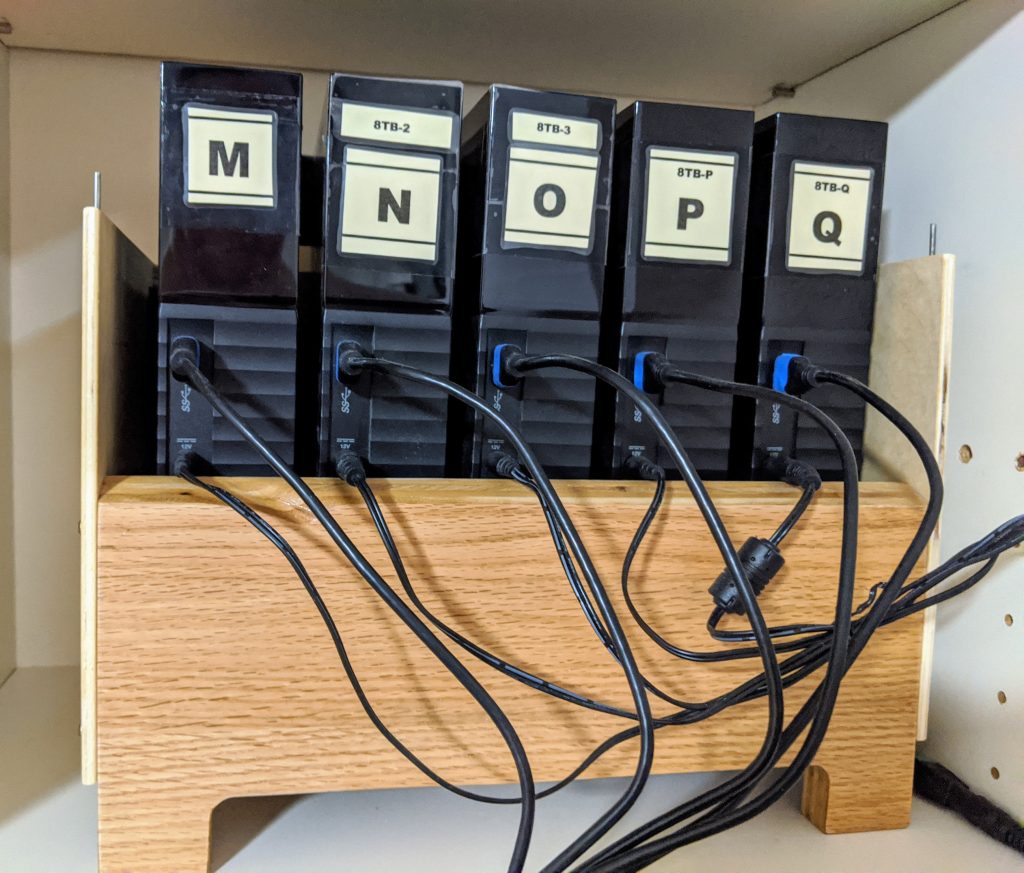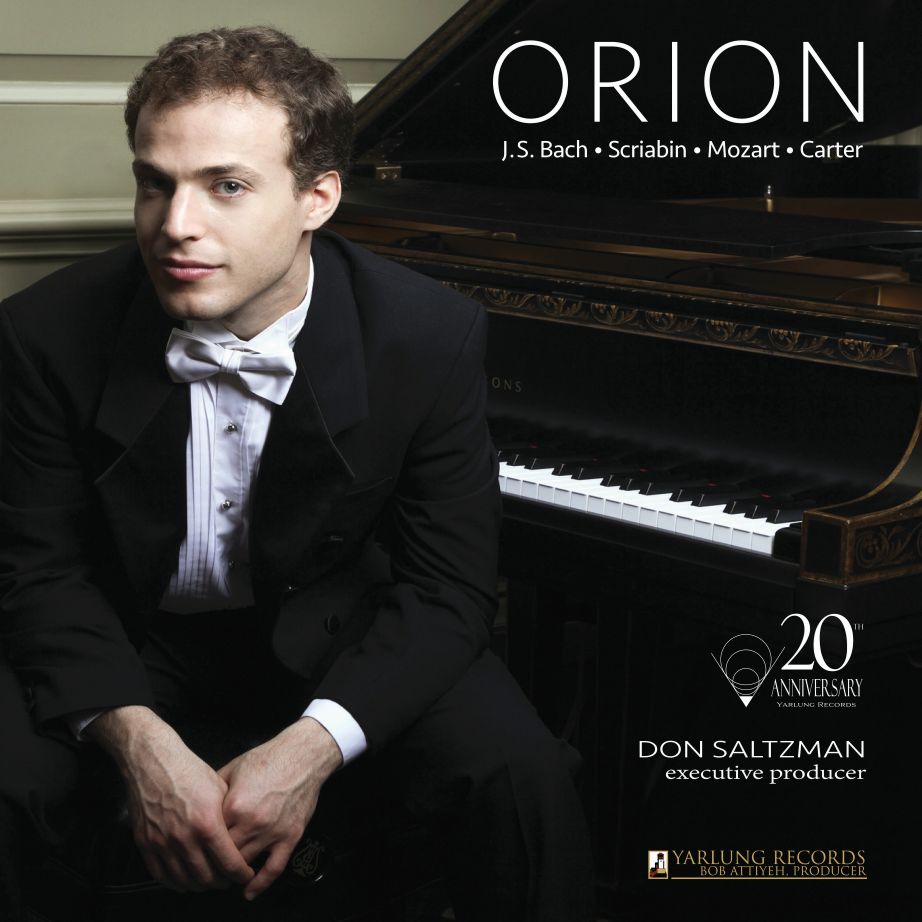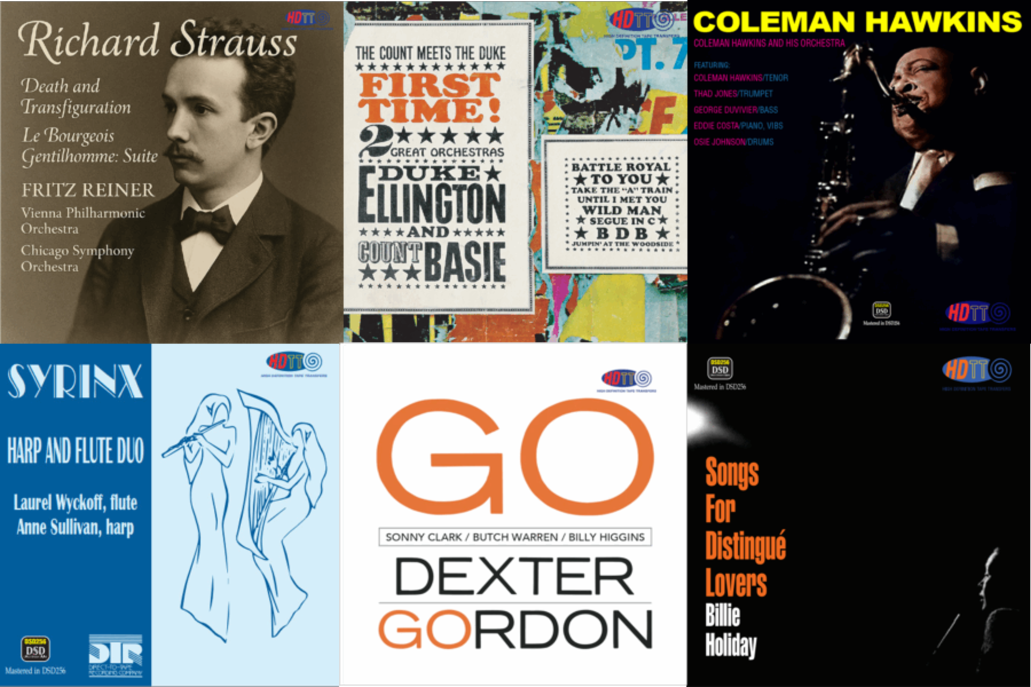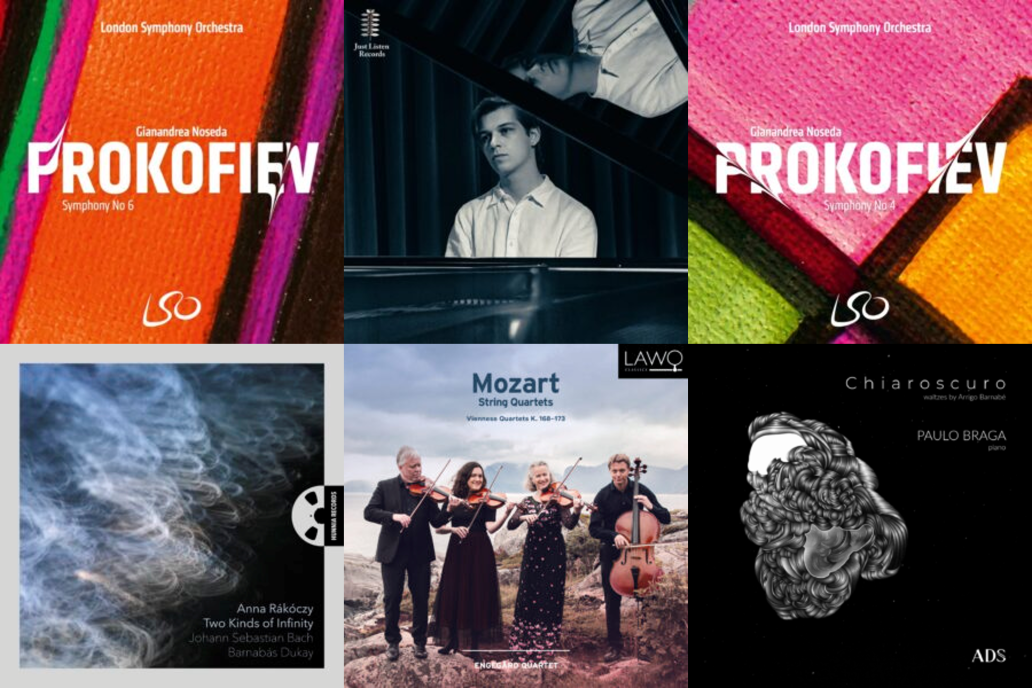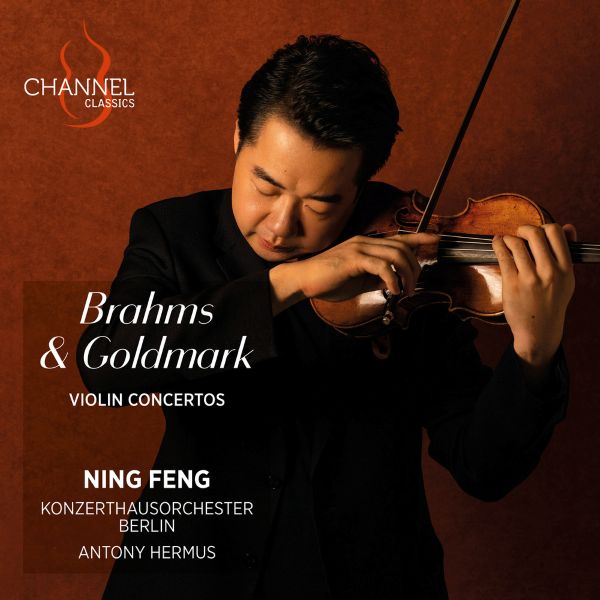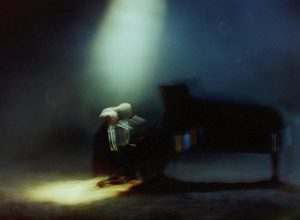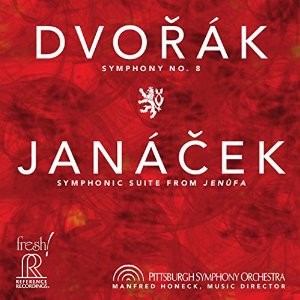Over the past four years, I've found myself regularly returning to recordings by the Spanish string quartet, Cuarteto Quiroga. Their performances are refined, beautifully played, nuanced in interpretation, and played with total conviction. They recently released their sixth album for Cobra Records, Und es Ward Licht! (below), and it's a stunner. It's well past time to write something about their recordings (all in delicious sound quality) and encourage you to sample some. As the New York Times says of this group: "Exquisite: precise, perfectly balanced, interpretively fresh performances, couched in consistently warm hues." Yes, indeed. So, in order from earliest release on Cobra Records to most recent release, here is Cuarteto Quiroga...
Statements: Haydn, Webern, Solima - Cuarteto Quiroga. Cobra Records 2011 DSD64 HERE
Spanning over 200 years, Cuarteto Quiroga explores what it means to write for a string quartet. In each case, the composer is making a statement about the music and where they wish to take it. Cuarteto Quiroga begins with the second of Haydn's Opus 20 string quartets: Divertimento a quattro Op. 20, No. 2 (1772). It is a work redolent in humor, drama, craftmanship, irony, lyricism, simplicity and boldness. Whew, what a list! Let's say it is Haydn laying down his expectations for where music needs to be moving. It is the beginning of his Sturm und Drang period of compositions that become more and more fully explored as he proceeds through the remaining quartets in his Opus 20 series of six quartets. He is exploring new harmonic territory in which the qualities of each individual instrument are emphasized.
Anton Webern (1883-1945), more than one hundred years later, faces the exhaustion of the Romantic idiom. His choice is to challenge himself and others to a new direction with the composition of his Langsamer Satz (Slow Movement) in 1905. This is a single movement from what was to be a longer quartet but which Webern never finished. It is a highly charged work, clearly rooted in post-Brahmsian romanticism and tonality, and expressing a plethora of emotions. From this beautifully tonal masterpiece, the Cuarteto Quiroga then move to Webern's Five Movements for String Quartet, Op. 5 (1910). a startling brief composition at a bit over 12 minutes. It is completely atonal and bristling with strange sounds from extended playing techniques, and arguably even more radical than Schoenberg's infamous second string quartet of 1908.
The album concludes with a first recording of a work written in 2008, Sonnets et Rondeaux, by Giovanni Sollima (b. 1962). Sollima is a composer of a newer generation which cannot escape the omnipresent influence of popular music and which flirts in a brilliant, instinctive and irreverent eclecticism with different traditions: from various folkish patterns of European cultures to minimalism and cinema.
This is excellent programming! An educational journey combined with outstanding music. And beautifully performed by Cuarteto Quiroga who fill the album with stylish energy.
(R)Evolutions: Schönberg, Webern, Berg - Cuarteto Quiroga. Cobra Records 2012 DSD64 HERE
Staying with Cuarteto Quiroga as they provide a masters class on the (R)evolution that was the Second Viennese School post 1900. They start with Schoenberg's first (and unpublished until 1966) String Quartet in D Major - a very tonal piece - and ending with Webern's Bagatelles, Op. 9, in which Webern plays about with the twelve sounds that will eventually configure his serial system. Fascinating connections, evolutions. Of course, the album ends where it all began, with Bach.
The tonality of the Schoenberg's String Quartet in D Major may come as bit of a shock for those of us carrying our impression of Schoenberg as that atonal twelve-tone "monster". When I mentioned to Ann that I had just listened to a lovely work by Schoenberg, she visibly shuddered. She's always less enjoyed modern atonal music than I. So, if you are like Ann in your reaction to the composer's name, go find this quartet and listen to it. It will really place Schoenberg in context for the work he did moving from the post-Romantic idiom and laying the foundations for a lot of modern music.
On the other hand, and opposite end of the spectrum, is Alban Berg's String Quartet No. 1, Op. 3 (1910). Now here is an atonal masterpiece that will set your nerves to vibrating. I LOVE IT. By modern standards, this actually sounds quite benign to my ears. Yet it turned the world on its collective ear. It was the first string quartet of recital length written in the strikingly new language of pervasive atonality. And yet, you can hear that its feet are firmly grounded in the late Romantic tradition—while dramatically challenging it. Cuarteto Quiroga is again giving us this education in the evolution of musical language over the decades.
Writes Kai Christiansen in Earsense about Berg's Opus 3: "With Schoenberg’s 12-tone technique still a good decade in the future, it follows Schoenberg’s own initial broach with atonality in his second string quartet a few years prior (1908) as well as Webern’s revolutionary Five Pieces for Orchestra just the year before (1909). Fifteen years later, Berg would compose his second string quartet, the Lyric Suite, a perfect bookend to the first string quartet illustrating Berg’s complete musical evolution. Ultimately, Berg’s celebrated works include his Violin Concerto and the opera Wozzeck."
Anton Webern is represented by his Six Bagatelles for String Quartet, Op. 9 (1911-1913), which present with all the evocative elegance of a haiku. Listen carefully as these begin. They will go by fast, with all but one being under a minute in duration. Here you have a musical reduction into intense wisps of sound that continue just long enough to penetrate one's consciousness. Full concentration is required. And, of course, it is completely atonal.
The album closes with an excerpt from Bach's St. Mathew's Passion: "Befehl du deine Wege (Herzlich tut mich verlangen)". One-minute, twenty-five seconds of bliss. Because, as Cuarteto Quiroga says that Webern would say, "everything happens in Bach." And thus ends their lesson for today about the evolution begun by Schoenberg, Berg and Webern.
To place a cherry on the top of this excellent performance and programming, the sound quality given us by Tom Peeters at Cobra Records is simply transportive. A rich, nicely reverberant, natural acoustic venue in which Tom captures beautifully the timbre of strings and resonance of wood. This is wonderfully recorded and presented album.
Brahms: The Opus 51 String Quartets - Cuarteto Quiroga. Cobra Records 2015 DSD64 HERE
Not to be played by the faint of heart! These quartets by Brahms are some of the most emotionally complex, and musically complex, quartets in the literature.
Published by Brahms in 1873 at the age of forty, these are his first two quartets. The imposing shadow of Beethoven's magnificent quartets, coupled with Brahms' own self-doubts, made completion of quartets he felt publishable an almost insurmountable task. Between publication and evidence of his first drafts, over twenty years had elapsed. These were not works of quick and easy gestation.
The greatness of Brahms lies in the honesty and depth of his music. To successfully perform Brahms, artists must shed their own ego and meet Brahms on his terms. To do otherwise creates an artificial outcome, one which too many performing quartets fall victim. The Cuarteto Quiroga are not caught out in this failure—they approach Brahms with an openness, an honesty, a degree of humility, and undeniable passion that does them and the music great credit. As Des Hutchinson of Music Web International has written, "here there's not only playing of breathtaking beauty and rapport, but a palpable grasp of the work’s structure, its meaning and its soul."
And this is what I find most engaging about listening to Cuarteto Quiroga. They are not only technically proficient, they do not only play with breathtaking beauty and rapport, but they truly dig into the meaning of the music. They are attuned to, and they convey, all of the emotional depth, anguish, joy, consternation, wonder, anxiety, conflict, remorse, reconciliation, that the composer may be striving to communicate. Never do they simply skate across the surface. And this is all so incredibly important when performing the dense complexities of Brahms' creations.
Simply top class music making here.
Terra, music of Bartók, Ginastera, Halffter - Cuarteto Quiroga. Cobra Records 2017 DSD64 HERE
In Terra, Cuarteto Quiroga explore music inspired by the essentially popular nature of music . As the booklet notes quote Louis Armstrong: "All music is folk music; I ain't never heard no horse sing a song." Music innately depends on associations between people, else it cannot be transmitted or having meaning. Thus, Cuarteto Quiroga chooses to share compositions of Béla Bartók, Alberto Ginastera and Rodolfo Halffter to provide some musical reflections on this thought.
Bartók's String Quartet No. 2 (1917) is a monumental example of the fusion of "folk" materials with the modern musical language. It was written not long after Bartók's immersion in the collection of folk music samples in Hungary and Romania. Rather than quoting traditional tunes, however, Bartók incorporates their syntax—he is updating and reinventing. Their performance is very fine; as fine as any that I have in my music library by other superb interpreters.
The same is true of Ginastera’s First Quartet (1948), which features gaucho rhythms, the emblematic guitar chords of the pampas and many other characteristics of the sound world of rural Argentina, and of Halffter’s fabulous Ocho Tientos (1973), a work in which the influence of Spanish music’s dazzling Renaissance past coexists with a multitude of attractive rhythmical and tonal elements drawn from the rich mosaic of Iberian music.
Throughout, the Cuarteto Quiroga perform with high creative energy, excellent ensemble, precise inflections and contrasts. It is no wonder that they won Spain’s National Music Award 2018 for this album. It deserves a much broader listening audience. You will NOT be disappointed with any of the performances found here. They are superb. Highly recommended!
Heritage, The Music of Madrid in the Time of Goya - Cuarteto Quiroga. Cobra Records 2019 DSD256 HERE
This is a beautifully performed album, once again applying some excellent programming sensibilities. I'm one of those odd ducks who prefer to play complete albums as the artists originally assembled the tracks. Consider me a throwback to the time when the artists sensibilities about what they were communicating actually mattered.
In this album, Cuarteto Quiroga gives us some exposure to what the Spanish court of the 18th century would have had access to and may actually have been listening to. One point that pops out immediately is that the first two selections are from Italian composers, Boccherini and Brunetti. And a third composer, Almeida, was born in Portugal. Canales is the only native son among them. But all four found patronage in Spain. This is a testament to the wealth and power that was Spain at this time.
As with all of their albums, the group sounds supremely well prepared, immensely engaged and engaging, and thoroughly conversant with the music they present for us. Their playing is, as always, immaculate.
Und es Ward Licht! - Cuarteto Quiroga. Cobra Records 2021 Pure DSD256 HERE
I am delighted each time I listen to this album. I am entranced by the superb musicianship, and I am in awe of a performing group that can so compellingly well interpret and present music of composers across five centuries with such broadly varying musical traditions. In this sixth album for Cobra Records, Cuarteto Quiroga returns to music of the Enlightenment with works by Haydn and Mozart.
The Cuarteto Quiroga perform with modern instruments but they bring to their performances of Haydn and Mozart a sympathy for historically informed musical practice using minimal vibrato and a light delicate touch. What makes these performances so special to me are the precise ensemble work, the high energy, and that ineluctable ability to apparently read each other's thoughts—a virtual mind-meld—in the realization of their creative objectives. They are just a joy to hear.
In the Mozart String Quintet in C Major, K.515, the quartet is joined by Veronika Hagen, viola. They don't miss a step.
As with their other albums, Cuarteto Quiroga has an educational component to their programming of this album. Until the mid-eighteenth century, instrumental music was essentially utilitarian. Its basic function was to illustrate a text, accompany a civil celebration or a religious liturgy, or add meaning to singing and dancing in general. However, a new generation of composers saw music as a new language unto itself. blew all of this away. Few works define this new compositional aesthetic, this quintessential modernism, as well as Haydn’s six Op. 33 quartets of 1781, of which No. 3 opens this album. The impact of the Op. 33 set was enormous. Mozart is known to have studied these pieces in fascination and was soon inspired to publish six quartets of his own. (Extracted and paraphrased from the enclosed booklet.)
Recorded by Tom Peeters in Pure DSD256 (no PCM), this is as transparent and highly resolving a recording as any in my collection—just beautifully recorded.
I said at the outset about this most recent album that "it's a stunner." Why? The performances are excellent, of course. But it is the sound quality that truly made me sit up straight and listen.
This is one of Tom's few Pure DSD256 releases. The sonics have a transparency that only Pure DSD256 releases deliver. Most of Tom's other releases are recorded in DSD256, but he pulls them into DXD for post processing (as is commonly done for mixing DSD files). But DXD is a lossy process. When output once again to DSD, we've lost some of the original sound quality. What I hear is a loss of high frequency information, a futzing of phase information, a subtle but noticeable loss of transparency. NOT IN THIS ALBUM! Here the final mastering has stayed in Pure DSD and the sonics are noticeably more transparent. It is a step up, even from the otherwise excellence of his DXD processed albums.
(Stay tuned for more information about mixing in DSD without moving the files to DXD/PCM. Once you've heard the transparency that Pure DSD256 can deliver, it is addictive.)
Cuarteto Quiroga
Formed in 2003, Cuarteto Quiroga takes its name from the Galician violinist Manuel Quiroga, one of the most outstanding string players in Spanish music history together with Pau Casals and Pablo Sarasate. For years the quartet was the ensemble in residence at the Royal Collection of decorated Stradivarius at Madrid’s Royal Palace. Today the quartet is Spain’s 2018 National Music Prize winning quartet-in-residence at Madrid’s Cerralbo Museum.
The recordings of Tom Peeters and Cobra Records
The beauty of performance on these albums is enhanced by the superb recordings made by Tom Peeters, producer and recording engineer for Cobra Records. As with so many of Tom's excellent recordings, we have a very happy combination of superb acoustic venue (the Westvest90 Church, Schiedam, The Netherlands) and masterful recording skills that both support and enhance the performance. Just gorgeous recordings.
I've come to know Tom through several conversations over the past few years, due largely to my huge respect for the recordings he makes. He records both for his own label, Cobra Records, and as a freelance producer/engineer for some other labels. A couple years ago, Tom and I had an extended conversation about his work and the artists who come to him. You can read that conversation HERE.
Tom Peeters in Westvest90 Church for a recording session, 2014. The Neumann Head Binaural microphone is shown with Tom's hand on top of it.
Today, Tom always makes his recordings in binaural, 2-channel stereo and 5.1 multichannel. If you listen to headphones, give his binaural recordings a try—they're great. See my article on his binaural recordings HERE.
All photos courtesy of Cobra Records.




